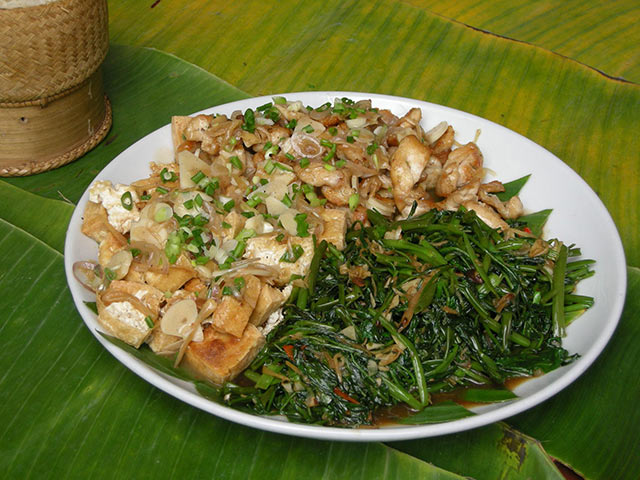 Le Laos est sans conteste l’une des plus belles destinations de la Péninsule indochinoise. Elle est non seulement connue pour ses paysages hors du commun, l’incroyable hospitalité de sa population, sa richesse culturelle, ses sites touristiques… mais aussi pour sa cuisine savoureuse. Une escapade gustative au cœur du Laos vous tente pour vos prochaines vacances ? La cuisine laotienne est certes peu connue dans le monde, mais recèle cependant d’innombrables richesses. Voici quelques destinations incontournables pour déguster la vraie gastronomie laotienne.
Le Laos est sans conteste l’une des plus belles destinations de la Péninsule indochinoise. Elle est non seulement connue pour ses paysages hors du commun, l’incroyable hospitalité de sa population, sa richesse culturelle, ses sites touristiques… mais aussi pour sa cuisine savoureuse. Une escapade gustative au cœur du Laos vous tente pour vos prochaines vacances ? La cuisine laotienne est certes peu connue dans le monde, mais recèle cependant d’innombrables richesses. Voici quelques destinations incontournables pour déguster la vraie gastronomie laotienne.
Il serait impensable de faire un voyage gourmand au Laos sans visiter la ville de Luang Prabang. En effet, il convient de noter que Luang Prabang est la capitale gastronomique du Laos. Située au nord du Laos, cette ville charmante reconnue pour sa nature luxuriante, ses paysages pittoresques, ses curiosités naturelles et sa cuisine variée.
➜ Continuez à lire "Où déguster la vraie gastronomie laotienne ?"
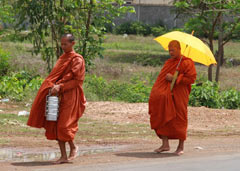 Voyager au Laos peut être l'un des moyens les plus intelligents de réaliser votre voyage en Asie. Vous « reculerez dans le temps », dans l’un des pays les moins industrialisés de l’Asie du Sud-Est, et vous plongerez dans la terre du puissant fleuve Mékong, qui traverse tout le pays et fournit une sortie vers la mer, avec ses longues plages de sable fin de la côte du Cambodge. Vous découvrirez une culture très ancienne, avec des racines bouddhistes. Généralement le Laos est une destination du Sud-Est asiatique ignorée, toutefois le pays est en pole position pour surprendre les voyageurs étrangers grâce à ses nombreuses attractions, des plages isolées aux forêts, à la faune exotique. Vous trouverez une multiplicité de choses à faire avec une visite de l'une des dernières frontières de l'Asie du Sud-Est. Nous vous assurons que le Laos est un pays d’une exceptionnelle variété géographique, et avec des minorités ethniques très intéressantes, et que voyager au Laos vous sera très utile : si vous envisagez d’interpréter vos vacances comme un voyage culturel en Asie, le Laos répondra à tous vos besoins.
Voyager au Laos peut être l'un des moyens les plus intelligents de réaliser votre voyage en Asie. Vous « reculerez dans le temps », dans l’un des pays les moins industrialisés de l’Asie du Sud-Est, et vous plongerez dans la terre du puissant fleuve Mékong, qui traverse tout le pays et fournit une sortie vers la mer, avec ses longues plages de sable fin de la côte du Cambodge. Vous découvrirez une culture très ancienne, avec des racines bouddhistes. Généralement le Laos est une destination du Sud-Est asiatique ignorée, toutefois le pays est en pole position pour surprendre les voyageurs étrangers grâce à ses nombreuses attractions, des plages isolées aux forêts, à la faune exotique. Vous trouverez une multiplicité de choses à faire avec une visite de l'une des dernières frontières de l'Asie du Sud-Est. Nous vous assurons que le Laos est un pays d’une exceptionnelle variété géographique, et avec des minorités ethniques très intéressantes, et que voyager au Laos vous sera très utile : si vous envisagez d’interpréter vos vacances comme un voyage culturel en Asie, le Laos répondra à tous vos besoins.

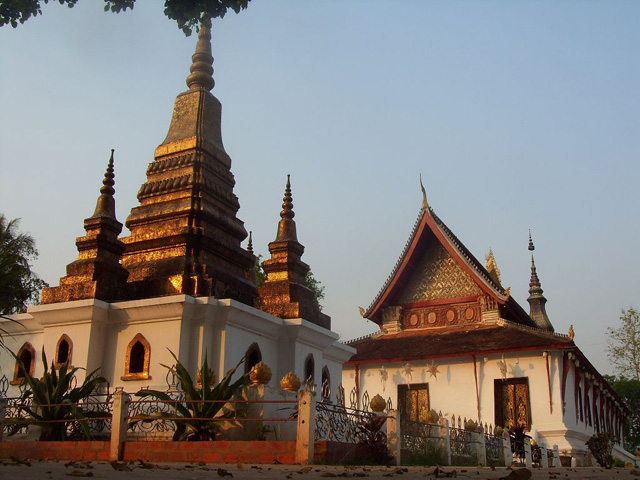 Quelques faits et statistiques sur Luang Prabang, la première ville du Royaume du Laos, bien connu pour ses nombreux temples et monastères bouddhistes, et ses moines, se promenant tous les matins dans les rues, demandant l'aumône.
Quelques faits et statistiques sur Luang Prabang, la première ville du Royaume du Laos, bien connu pour ses nombreux temples et monastères bouddhistes, et ses moines, se promenant tous les matins dans les rues, demandant l'aumône.
1353 : l'année durant laquelle la ville (connue autrefois sous le nom de Xieng Dong Xieng Thong) est devenue la capitale officielle du premier Royaume Lao, Lan Xang.
32 : le nombre de temples dans la ville désignée site du patrimoine mondial de l'UNESCO en 1995.
➜ Continuez à lire "Luang Prabang en chiffres"
Patuxai (littéralement la Porte de la Victoire ou la Porte du Triomphe), autrefois appelée le monument Anousavary ou Anosavari, se trouve au centre de Vientiane, Laos et fut construit dans les années 60.
C'est un monument dédié aux victimes de la guerre pour l'indépendance vis a vis de la France. Bien qu'il ressemble clairement à l'Arc de Triomphede Paris, celui-ci est typiquement Laotien, décoré avec des personnages Kinnari - moitié femme, moitié oiseau.
➜ Continuez à lire "Patuxai, l'Arc de Triomphe de Vientiane au Laos"
Situé à mi-chemin entre Vientiane et Luang Prabang, Vang Vieng est devenue une étape incontournable pour les backpacker's qui visitent le Laos. Entouré de paysages magnifiques et débordant d'activités (Visite des grottes et "tubing" dans la rivière étant les 2 plus appréciées), l'endroit est particulièrement apprécié et beaucoup y prolongent leur séjour.
La ville est tellement remplie de guesthouses, de restaurants et de magasins qu'il est même difficile de savoir quoi faire en arrivant. Quasiment toutes les boutiques de cette petite ville à la croissance phénoménale fournissent des produits ou des services pour les touristes.
En revanche, si vous recherchez la pure "Lao culture", Vang Vieng n'est pas l'endroit idéal.

 Localisation Province de Champassak, Laos
Localisation Province de Champassak, Laos
Coordonnées N14 50 54 E105 49 20
Bien 39 000 ha
Date d'inscription 2001
Brève description (http://whc.unesco.org/fr/list/481 ![]() )
)
Le paysage culturel de Champassak, y compris l'ensemble du temple de Vat Phou, représente une zone de paysage planifiée remontant à plus de mille ans et remarquablement bien conservée. Afin d'exprimer la conception hindoue des rapports entre la nature et l'homme, il a été façonné selon un axe compris entre le sommet de la montagne et les rives du fleuve dans un entrelacs géométrique de temples, de sanctuaires et d'ouvrages hydrauliques s'étendant sur quelque 10 km. Le site comprend aussi deux villes anciennes, construites sur les rives du Mékong et la montagne de Phou Kao, l'ensemble représentant un processus d'aménagement s'étendant sur plus de mille ans, du Ve au XVe siècle, associé surtout à l'Empire khmer.
Photos de Landolia
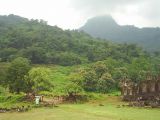 |
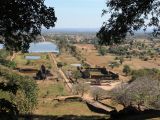 |
Plus de photos du Vat Phou et les anciens établissements associés du paysage culturel de Champassak

 Localisation Palaos
Localisation Palaos
Coordonnées N7 14 48.93 E134 21 9
Bien 100 200 ha
Date d'inscription 2012
Brève description (http://whc.unesco.org/fr/list/1386 ![]() )
)
Ce site de 100 200 hectares compte 445 îlots calcaires inhabités. D’origine volcanique, les îlots ont souvent la forme de champignons entourés de lagons couleur turquoise et de récifs coralliens. La beauté du site est renforcée par un système complexe de récifs comptant 385 espèces de coraux et différents types d’habitat. Ces derniers hébergent une grande variété de plantes, d’oiseaux et d’animaux marins, notamment des dugongs et au moins treize espèces de requins. Le site représente la plus grande concentration de lacs marins au monde. Ces masses d’eau de mer, isolées de l’océan par une barrière terrestre, sont caractéristiques de ces îles et se traduisent par un endémisme élevé qui peut laisser espérer la découverte de nouvelles espèces. Les vestiges des villages en pierre, ainsi que l’art rupestre et les sépultures, apportent un témoignage exceptionnel sur l’organisation des communautés des petites îles pendant plus de trois millénaires. L’abandon des villages des îles Chelbacheb aux XVIIe et XVIIIe siècles illustre les conséquences du changement climatique, de l’essor démographique et du comportement de subsistance dans une société vivant dans un environnement marin marginal.
Photos de Landolia
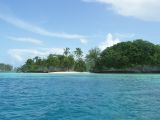 |
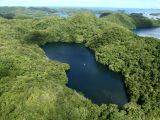 |
Plus de photos du lagon sud des îles Chelbacheb

 Localisation Luang Prabang, Laos
Localisation Luang Prabang, Laos
Coordonnées N19 53 20.004 E102 7 59.988
Bien 820 ha
Date d'inscription 1995
Brève description (http://whc.unesco.org/fr/list/479 ![]() )
)
Cette ville reflète la fusion exceptionnelle de l'architecture traditionnelle et des structures urbaines conçues par les autorités coloniales européennes aux XIXe et XXe siècles. Son paysage urbain unique, remarquablement bien conservé, illustre une étape majeure du mélange de ces deux traditions culturelles différentes.
Photos de Landolia
 |
 |
 |
Plus de photos de la ville de Luang Prabang
 Le Blog compagnon de Landolia, choisissez votre prochaine destination et préparez votre voyage. Vous avez un article intéressant sur une destination à partager ? Jetez un œil à nos directives de soumission d’article.
Le Blog compagnon de Landolia, choisissez votre prochaine destination et préparez votre voyage. Vous avez un article intéressant sur une destination à partager ? Jetez un œil à nos directives de soumission d’article.